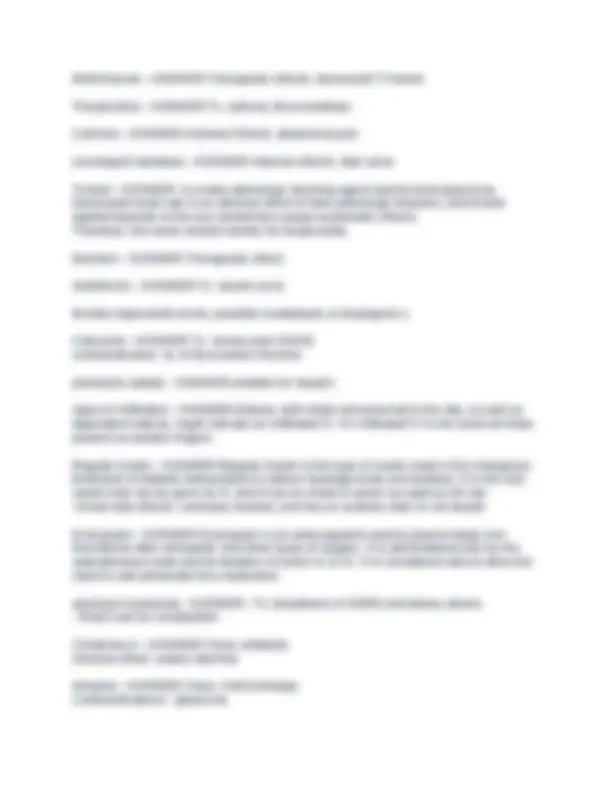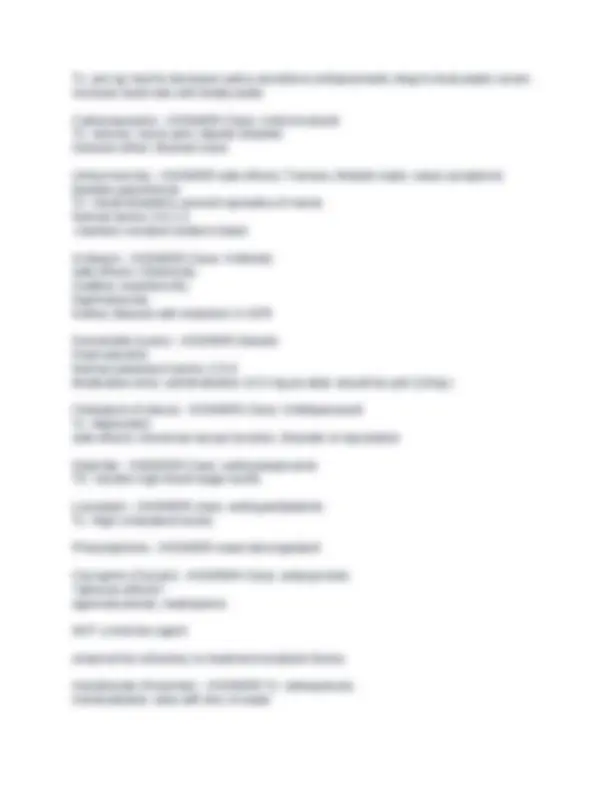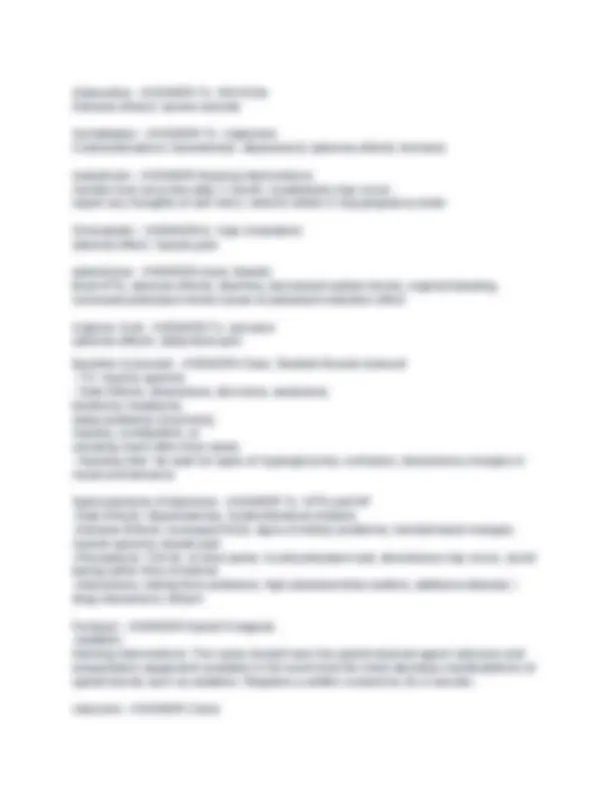





Study with the several resources on Docsity

Earn points by helping other students or get them with a premium plan


Prepare for your exams
Study with the several resources on Docsity

Earn points to download
Earn points by helping other students or get them with a premium plan
Community
Ask the community for help and clear up your study doubts
Discover the best universities in your country according to Docsity users
Free resources
Download our free guides on studying techniques, anxiety management strategies, and thesis advice from Docsity tutors
Nystatin - ANSWER-should be applied topically to the area affected with candidiasis, usually four times daily. Adults and older children can swish the nystatin suspension around in their mouth for a period of time and then swallow it. Since infants and very young children cannot follow these directions, the medication should be applied orally using a swab. Prothrombin Time (PT) - ANSWER-used to monitor warfarin therapy NPH insulin - ANSWER-peak: 4-14hrs duration: tobramycin - ANSWER-30 mins before and after for lab values Meperidine (Demerol) - ANSWER-Tx: Moderate to severe pain Contraindications: Hypotension (SBP <100), respiratory depression, respiratory distress due to asthma/COPD, shock, bowel obstruction, patients who have taken MAOIs within the past 2 weeks Class: Opiod Analgesic
Typology: Exams
1 / 6

This page cannot be seen from the preview
Don't miss anything!




Nystatin - ANSWER-should be applied topically to the area affected with candidiasis, usually four times daily. Adults and older children can swish the nystatin suspension around in their mouth for a period of time and then swallow it. Since infants and very young children cannot follow these directions, the medication should be applied orally using a swab. Prothrombin Time (PT) - ANSWER-used to monitor warfarin therapy NPH insulin - ANSWER-peak: 4-14hrs duration: tobramycin - ANSWER-30 mins before and after for lab values Meperidine (Demerol) - ANSWER-Tx: Moderate to severe pain Contraindications: Hypotension (SBP <100), respiratory depression, respiratory distress due to asthma/COPD, shock, bowel obstruction, patients who have taken MAOIs within the past 2 weeks Class: Opiod Analgesic Cumulative Effects - ANSWER-- effect occurs with repeated doses of a medication are given and the rate of administration exceeds the rate of metabolism or excretion. Due to older adults decreased kidney function, meperidine can quickly reach a toxic level when given over several days, which can cause seizures. Dimenhydrinate - ANSWER-antihistamine tx nausea It is used to treat acute attacks of Meniere's disease and vertigo, as well as to reduce nausea and vomiting from radiation sickness. Digoxin toxicity - ANSWER-GI effects (anorexia, n/v, abdominal pain), CNS effects (fatigue, weakness, diplopia, blurred vision, yellow-green or white halos around objects) -Anorexia- -Loop diuretics such as furosemide can cause hypokalemia, which greatly increases the risk of digoxin toxicity. Tx: is used to treat heart failure, usually along with other medications. It is also used to treat certain types of irregular heartbeat (such as chronic atrial fibrillation). Class: Cyclobenzaprine - ANSWER-Muscle Relaxant
Omeprazole - ANSWER-a proton pump inhibitor
Tx: pre op med to decrease saliva secretions antispasmodic drug to treat peptic ulcers increase heart rate with bradycardia Carbamazepine - ANSWER-Class: Anticonvulsant Tx: seizure, nerve pain, bipolar disorder Adverse effect: Blurred vision Lithium toxicity - ANSWER-side effects: Tremors, Metallic taste, neuro symptoms besides parenthesia Tx: mood disorders, prevent episodes of mania Normal levels: 0.6-1. -maintain constant sodium intake Amikacin - ANSWER-Class: Antibiotic side effects: Ototoxicity, Auditory neurotoxicity, Nephrotoxicity, Kidney disease with reduction in GFR Furosimide (Lasix) - ANSWER-Diuretic Fluid retention Normal potassium levels: 2.5- Medication error: administration 10.0 mg po daily should be just (10mg ) Citalopram (Celexa) - ANSWER-Class: Antidepressant Tx: depression side effects: Abnormal sexual function, Disorder of ejaculation Glipizide - ANSWER-Class: antihyperglycemic TX: monitor high blood sugar levels Lovastatin - ANSWER-class: antihyperlipidemic Tx: High cholesterol levels Phenylephrine - ANSWER-nasal decongestant Clozapine (Clozaril) - ANSWER-Class: antipsychotic adverse effects- agranulocytosis, neutropenia NOT a first-line agent reserved for refractory or treatment-resistant illness Alendronate (Fosamax) - ANSWER-Tx: osteoporosis Administration: take with 8oz of water
Zidovudine - ANSWER-Tx: HIV/AIDs Adverse effects: severe anemia Sumatriptan - ANSWER-Tx: migraines Contraindications: fluoxetine(tx: depression) (adverse effects: tremors) Isotretinoin - ANSWER-Nursing interventions: monitor liver enzymes after 1 month, nosebleeds may occur , report any thoughts of self harm, need to obtain 2 neg pregnancy tests Simvastatin - ANSWER-tx: high cholesterol adverse effect: muscle pain eplerenone - ANSWER-class: diuretic treat HTN, adverse effects; diarrhea, decreased sodium levels, vaginal bleeding, increased potassium levels cause of potassium retention effect Valproic Acid - ANSWER-Tx: seizures adverse effects: abdominal pain Baclofen (Lioresal) - ANSWER-Class: Skeletal Muscle relaxant